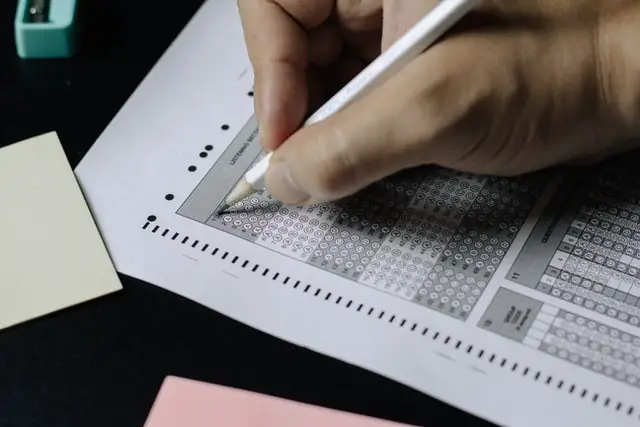Old SAT to New SAT Conversion Chart [Easy Guide]
The SAT went through some changes in 2016. Learn about the remodeling of the SAT score system, old SAT to new SAT conversion, and more.
The Scholastic Assessment Test (SAT) is a centralized entrance exam that various educational institutions in the United States use to streamline college admission. The SAT Format underwent various amendments, notably in 2016, to better assess students’ readiness for college.
The journey of the old SAT to the new SAT demonstrated several changes in the test’s pattern, scores, and more. One such change is in the total score of the test. The original score of 2400 was reduced to 1600.
What is the SAT? It is a 3-hour, (excluding essay) pencil-paper examination consisting of multiple-choice questions for primarily three sections- reading, writing, and mathematics. The College Board offers the SAT 7 times a year worldwide. The scorecard for the SAT exhibits a scale of 400-1600.
The SAT composite score is the computed summation of critical reading and writing and math scores. Each of these categories are examined on a scale of 200-800 (individually).
Old SAT to New SAT - The Basics
The New SAT demonstrates a few changes in score remodeling, sections, and question logistics:
Score Remodeling
In March 2016, the College Board remodeled the scoring system of the SAT. The total score shifted from a 2400-marks scale to a 1600-marks scale.
Although you must combine the scores of each SAT section to calculate your total SAT score, the two-section scores are quite dissimilar when comparing section-wise scores and total scores.
Hence, to obtain the most accurate results, experts recommend that each SAT section is scored separately.

Revised Sections and Optional Essay
The new SAT incorporates two sections - Evidence-Based Reading and Writing (EBRW), and Mathematics. Both sections are equally important, holding the same weight.
The EBRW section comprises 52 questions,15 questions less than the original 67 questions of the old SAT reading section.
The College Board also included an optional essay component in the new SAT. Unlike the old SAT, the new SAT has a consolidated math section comprising two subsections: one that grants the use of the calculator, and one that prohibits it.
Convert Old SAT to New SAT
Overall, the changes to the SAT from 2016 were extensive. There was a consolidation of sections, change in the scoring methodology, and inclusion of a supplemental essay component.
The new composite, or total SAT score, is 1600. Each section (EBRW, and Math) is scored on a scale of 200 to 800. The sum total of both sections, a total maximum of 1600, forms the total SAT score. Let us look closely at the old SAT to new SAT composite, as well as at a score conversion chart for each individual section.
|
Convert Old SAT to New SAT Composite Score |
|
|
Old SAT ( Critical Reading + Writing + Math) |
New SAT (EBRW + Math) |
|
600 |
400 |
|
610 |
410 |
|
620 |
420 |
|
630 |
430 |
|
640 |
440 |
|
650 |
450 |
|
660 |
460 |
|
670 |
470 |
|
680 |
480 |
|
690 |
490 |
|
700 |
500 |
|
710 |
510 |
|
720 |
520 |
|
730 |
530 |
|
730 |
540 |
|
740 |
550 |
|
750 |
560 |
|
760 |
570 |
|
770 |
580 |
|
780 |
590 |
|
790 |
600 |
|
800 |
610 |
|
810 |
620 |
|
820 |
630 |
|
830 |
640 |
|
840 |
650 |
|
850 |
660 |
|
860 |
670 |
|
870 |
680 |
|
880 |
690 |
|
900 |
700 |
|
910 |
710 |
|
930 |
720 |
|
950 |
730 |
|
960 |
740 |
|
980 |
750 |
|
990 |
760 |
|
1010 |
770 |
|
1030 |
780 |
|
1040 |
790 |
|
1060 |
800 |
|
1070 |
810 |
|
1090 |
820 |
|
1110 |
830 |
|
1120 |
840 |
|
1140 |
850 |
|
1150 |
860 |
|
1170 |
870 |
|
1180 |
880 |
|
1200 |
890 |
|
1210 |
900 |
|
1220 |
910 |
|
1240 |
920 |
|
1250 |
930 |
|
1270 |
940 |
|
1280 |
950 |
|
1300 |
960 |
|
1310 |
970 |
|
1330 |
980 |
|
1340 |
990 |
|
1360 |
1000 |
|
1370 |
1010 |
|
1390 |
1020 |
|
1400 |
1030 |
|
1420 |
1040 |
|
1430 |
1050 |
|
1450 |
1060 |
|
1460 |
1070 |
|
1480 |
1080 |
|
1490 |
1090 |
|
1510 |
1100 |
|
1530 |
1110 |
|
1540 |
1120 |
|
1560 |
1130 |
|
1570 |
1140 |
|
1590 |
1150 |
|
1610 |
1160 |
|
1620 |
1170 |
|
1640 |
1180 |
|
1650 |
1190 |
|
1670 |
1200 |
|
1680 |
1210 |
|
1700 |
1220 |
|
1710 |
1230 |
|
1730 |
1240 |
|
1750 |
1250 |
|
1760 |
1260 |
|
1780 |
1270 |
|
1790 |
1280 |
|
1810 |
1290 |
|
1820 |
1300 |
|
1840 |
1310 |
|
1850 |
1320 |
|
1870 |
1330 |
|
1880 |
1340 |
|
1900 |
1350 |
|
1920 |
1360 |
|
1930 |
1370 |
|
1950 |
1380 |
|
1970 |
1390 |
|
1990 |
1400 |
|
2000 |
1410 |
|
2020 |
1420 |
|
2040 |
1430 |
|
2060 |
1440 |
|
2080 |
1450 |
|
2090 |
1460 |
|
2110 |
1470 |
|
2130 |
1480 |
|
2150 |
1490 |
|
2170 |
1500 |
|
2190 |
1510 |
|
2210 |
1520 |
|
2230 |
1530 |
|
2260 |
1540 |
|
2280 |
1550 |
|
2300 |
1560 |
|
2330 |
1570 |
|
2350 |
1580 |
|
2370 |
1590 |
|
2390 |
1600 |

Since there were no changes in the total score of the Math section of the SAT, the conversion process for this section is quite simple. The figures remain the same in both the old and new scores.
|
Old SAT Math to New SAT Math Score
|
|
|
Old SAT Math |
New SAT Math |
|
200 |
200 |
|
200 |
210 |
|
210 |
220 |
|
220 |
230 |
|
220 |
240 |
|
230 |
250 |
|
240 |
260 |
|
240 |
270 |
|
250 |
280 |
|
260 |
290 |
|
260 |
300 |
|
270 |
310 |
|
280 |
320 |
|
280 |
330 |
|
290 |
340 |
|
300 |
350 |
|
310 |
360 |
|
330 |
370 |
|
340 |
380 |
|
350 |
390 |
|
360 |
400 |
|
370 |
410 |
|
380 |
420 |
|
390 |
430 |
|
400 |
440 |
|
410 |
450 |
|
420 |
460 |
|
430 |
470 |
|
440 |
480 |
|
450 |
490 |
|
460 |
500 |
|
470 |
510 |
|
490 |
520 |
|
500 |
530 |
|
510 |
540 |
|
520 |
550 |
|
530 |
560 |
|
550 |
570 |
|
560 |
580 |
|
570 |
590 |
|
580 |
600 |
|
590 |
610 |
|
600 |
620 |
|
610 |
630 |
|
620 |
640 |
|
630 |
650 |
|
640 |
660 |
|
650 |
670 |
|
650 |
680 |
|
660 |
690 |
|
670 |
700 |
|
680 |
710 |
|
690 |
720 |
|
700 |
730 |
|
710 |
740 |
|
720 |
750 |
|
740 |
760 |
|
750 |
770 |
|
760 |
780 |
|
780 |
790 |
|
800 |
800 |
While the older version of Reading + Writing SAT was calculated out of 1600, with both Reading and Writing sections consisting of 800 each, the new version of EBRW SAT section is scored out of 800 in total.
|
Old SAT (Critical Reading + Writing) to New SAT (EBRW) Score
|
|
|
Old SAT (Critical Reading + Writing) |
New SAT (EBRW) |
|
400 |
200 |
|
410 |
210 |
|
420 |
220 |
|
430 |
230 |
|
440 |
240 |
|
440 |
250 |
|
450 |
260 |
|
460 |
270 |
|
470 |
280 |
|
480 |
290 |
|
490 |
300 |
|
500 |
310 |
|
520 |
320 |
|
550 |
330 |
|
570 |
340 |
|
600 |
350 |
|
620 |
360 |
|
640 |
370 |
|
660 |
380 |
|
690 |
390 |
|
710 |
400 |
|
730 |
410 |
|
750 |
420 |
|
770 |
430 |
|
790 |
440 |
|
800 |
450 |
|
820 |
460 |
|
840 |
470 |
|
860 |
480 |
|
880 |
490 |
|
890 |
500 |
|
910 |
510 |
|
930 |
520 |
|
950 |
530 |
|
970 |
540 |
|
990 |
550 |
|
1010 |
560 |
|
1020 |
570 |
|
1040 |
580 |
|
1060 |
590 |
|
1080 |
600 |
|
1100 |
610 |
|
1120 |
620 |
|
1150 |
630 |
|
1170 |
640 |
|
1190 |
650 |
|
1210 |
660 |
|
1240 |
670 |
|
1260 |
680 |
|
1290 |
690 |
|
1310 |
700 |
|
1340 |
710 |
|
1370 |
720 |
|
1390 |
730 |
|
1420 |
740 |
|
1450 |
750 |
|
1480 |
760 |
|
1510 |
770 |
|
1540 |
780 |
|
1560 |
790 |
|
1590 |
800 |
The data from the above charts were retrieved from the official College Board website. Experts recommend that you convert section-wise scores to get an accurate composite SAT score. Conversely, if you need a new SAT to old SAT conversion, this chart can also help you easily do that too.
For instance, if you scored an SAT Math score of 650, the new SAT Math would come up to 680 (as per the conversion chart). Tally both your scores (for each section), and calculate your total score accordingly. Once you have your scores, compare them with average SAT scores.
Conclusion
The SAT, like many examinations, can be amended when there’s a need for improvement, or if there is a shift in world circumstance, like the COVID-19 pandemic. The new SAT scoring vs. old scoring is more demonstrative of a student’s readiness for college.
Blogs you might be interested in